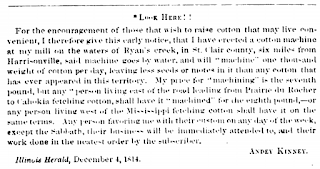The mill was the center of commerce in Monroe City. It originally ground flour for the St. Louis market and eventually for shipment across the country. The flour was shipped on steamboats which docked at nearby Harrisonville Landing on the Mississippi River. The mill was supported by other trades. Several coopers made flour barrels. The cooper shed at Foster’s is preserved today with many barrel parts intact. Timber was cut on a large scale to supply firewood for steamboats. When the railroad came through in the early 1900‘s, railroad cross tie production was a substantial business.
In 1793, Joseph Kinney purchased the property. In 1800, his son Andrew built a grist mill to grind wheat and corn. He built a dam on the creek upstream to collect a head of water to power the wheel. By 1812, the mill shipped flour to St. Louis and international markets. In 1814, Kinney installed a water-powered "cotton machine" which would clean 1,000 pounds per day. He charged "the 7th pound" for local residents and "the eighth pound for customers east of the Kaskaskia Trail or west of the Mississippi.
Thomas James bought the property in 1823. In 1827 he rebuilt the mill with greater capacity. John Great of Maryland was the rock mason hired for the construction. To support this mill, a new dam was built at the spring high in the hollow. An iron pipe carried water to the wheel. The waterwheel powered rock grindstones which ground wheat into flour. At one point the mill burned, but was reconstructed quickly.
In 1850, Gottleib Ziebold purchased the mill. He converted the mill to steam power in 1851. In 1882, his son George W. became manager and modernized the mill. He hired Charles Duryea of Richmond, Indiana to perform the modernization. He upgraded the mechanicals and replaced the rock grindstones with modern steel rollers. Duryea moved on to open a bicycle shop in Peoria, IL and invented the first steam-powered automobile, the Duryea. His name can still be seen inscribed in charcoal graffiti on a wall inside the Madonnaville cave.
The steam boilers required constant attention. One day late in the 1880’s or early 1890's, the operator went to the tavern for a quick beer. While he was out, pressure built quickly to dangerous levels. The boiler exploded, effectively ending the mill business in Monroe City.
The mill had a small office area on the north side. At one time, it housed the James Mill Post Office and eventually, the Monroe City Post Office. The post office was discontinued in 1906. In 1923, Gustav Hirsch sent Harold G. Baum to barber school. Harold operated a barber shop in this office area for a few years.
The mill building fell into disrepair. The rock was salvaged throughout the 1970’s and 1980’s. The rock wheel arch is all that remains of the mill.
The mill building fell into disrepair. The rock was salvaged throughout the 1970’s and 1980’s. The rock wheel arch is all that remains of the mill.
 |
| The dam at the Spring. The pipe in the photo below carried water to the Mill. This pipe was installed after the original dam, downstream, was washed away. |








No comments:
Post a Comment